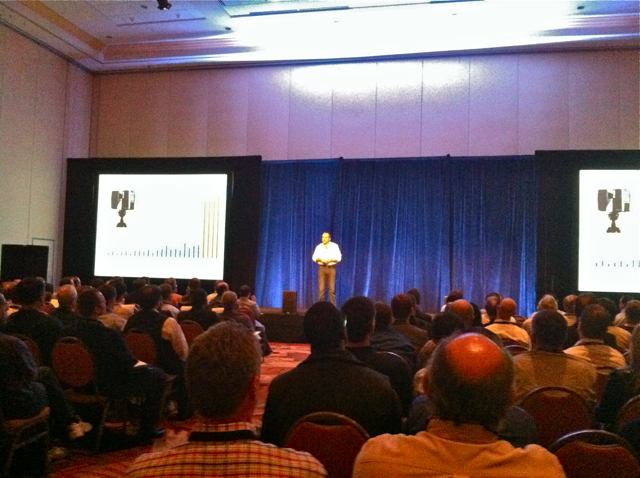‘There’s not a doubt in my mind following the 2011 results.’
ORLANDO, Fla. – Kicking off the company’s first North American 3D Documentation Conference here, FARO CEO Jay Freeland did not mince words: “We are #1 in laser scanning. There’s not a doubt in my mind following the 2011 results.”
Dressed in jeans, a shirt open to the second button, and a necklace, Freeland projected a casual confidence as he ticked off the company’s value propositions, emphasizing especially FARO’s desire to be disruptive in form factor, technology, and price.
Speaking of the company’s Focus3D laser scanning product, Freeland said, “It’s extremely easy to handle, with a built-in color option, no camera strapped to the top. It’s got a built-in five-hour battery and can now really be used as a field instrument. It’s got a simple touch-screen interface, so no more need for a laptop. And it gathers nearly one million points per second at 120-meter range with 1 to 2 millimeters in accuracy.
“And,” he continued, “there was a 60 percent reduction in price. That moved a whole slug of people into the FARO camp … In our opinion, there’s nothing like this product in the marketplace.”
He then showed a slide with a bar graph, with no attendant numbers, detailing laser scanner sales. The bars for every quarter starting with the first quarter of 2011 were four-to-five times as large as any previous quarter. The sales following the product’s announcement at INTERGEO in October of 2010 surprised even FARO: Freeland admitted that at one point it was taking as many as six months to deliver on Focus3D orders.
“For those of you who needed to wait a while, for us to get the production network up, that we’ve solved,” he promised.
However, those who are hoping for a yet smaller, lighter, and cheaper Focus ought not to hold their breath, Freeland said. “This is a solid generation,” he said, donning fully his sales hat. “Don’t wait to buy the Focus LS. It’s going to be a while before the next gen comes out.” What does a while mean? “It will not happen in 2012, but it will be well before 2017,” he chuckled. “Is that non-committal enough?”
In fact, FARO’s big product news at the 3D Documentation Conference was software-focused. The company announced the release of its FARO Scene 5.0 point cloud processing software, which includes support for ASTM’s e57 point cloud standard, a new octree databasing structure that allows for the viewing of entire projects in one easily navigable point cloud, cloud-to-cloud targetless registration, and the ability to display in stereo 3D.
Further, the 5.0 release makes Scene for the first time developer-friendly. “We stop at the octree database and then invite our partners to work with us,” said Bernd Becker, FARO director of marketing and product managment for laser scanning and
co-founder of original scanner-maker iQvolution, which FARO purchased for roughly $12 million back in 2005. Scene 5.0 is now “like the app store,” Becker said, “we think lower-cost and easier-to-use solutions can be built this way.”
“We are not going to be one-stop-shop software,” Becker said. “Other partners can connect to our point cloud and create all kinds of applications. You can create your own apps if you want,” he told the audience.
In a product demonstration of 5.0, senior technical product manager for laser scanners Oliver Bürkler said no apps were yet available, but to expect FARO to develop a couple in short order to demonstrate the functionality to other developers.
In demonstrating the navigation of a 4.5 billion point project and the targetless registration from his laptop, Bürkler put on an impressive show. He said users could expect roughly two to three minutes per scan of processing time on a 64-bit work station with eight gigs of RAM in creating the project point cloud, which allows for easy navigation thanks to the octree database that stores information efficiently and only displays those points you’re requesting in the moment.
The targetless, virtually automatic registration works best in feature-filled scan environments, and may not perform well in featureless and symmetrical scenes, Bürkler said. However, should you employ targets, that automatic registration process has been made more efficient with an architecture that is able to compare just those points surrounding the targets, cloud to cloud.
If the technology wasn’t enough to convince conference attendees to hitch their wagons to FARO, though, CEO Freeland still had a financial strength argument in his back pocket. “We have global customer support – there are almost 1,000 employees at FARO now around the world,” he said. “We have almost a billion in market cap, have been growing steadily at roughly 25 percent a year – except for 2009. We have $100 million in cash, and no debt, and that allows us to fund the R&D necessary to continue to be disruptive with our technology.”
“We will remain number one” in laser scanning, he vowed. “That’s a bold statement. I get it. But if your dreams don’t scare you, then they aren’t big enough. That’s the type of company we are.”






